In our 46th edition of the Donut Dollie Detail, Gloria tells that thanks to a Korean baker (Mr. Kim), she was able to bring donuts to the men, how the Donut Dollies would visit the men of the Mobile Riverine Force, and that she and the other women loved their country and serving the men.
Please share the Donut Dollie Detail with family, friends and veterans you may know, and make sure to like/follow us on Facebook to learn when the next edition is posted.
Please meet Red Cross Donut Dollie Gloria Glover Gates…
What prompted you to join the SRAO (Supplemental Recreation Activities Overseas) program and want to go to Korea and then Vietnam?
The offer to go to South Korea and serve with our military. How exciting and different from anything I could have imagined doing right out of college.
———————————————————————————————————————————————-
When and where were you stationed in Korea and Vietnam? Did you go by a nickname?
After two weeks of training at the American Red Cross headquarters in Washington, D.C., we boarded a flight to Tacoma, Washington. There we waited for the next military flight to Seoul, Korea. We arrived in Korea on September 12, 1967. After more training at SRAO headquarters in Seoul we traveled to our assigned units. I was stationed at Camp Humphreys, home of the 28th Field Support Group from September until the first week of January of 1967. In early January of 1968 I left Korea for Vietnam and arrived at the Bear Cat base (9th Infantry Division). I was known as Gloria in both Korea and Vietnam.
What was a routine day like in Korea and Vietnam?
In Korea, we lived on base and worked out of an office provided by the military. We had a truck and driver assigned to us, and a baker, Mr. Kim, who made dozens of donuts every day. We delivered them to the men we visited. Our programs were popular, but the men really loved the donuts. We carried boxes with 5 dozen donuts in each box. If we were headed out on a long run we would tie 5 boxes together. We traveled by truck, train or bus that would get us to the village closest to the unit we were visiting. Riding the train or bus gave us opportunity to meet many of the Korean people. Of course the children knew our schedule better than we did. We gave away many of the donuts before we got to the men. That is why we took so many. Our programs provided fun opportunities to give the men time away from their daily routine. They were so glad to have us visit and loved to talk with us about home and family.
Two of us volunteered to transfer to Vietnam after some of the Donut Dollies had to go home early. We left Korea in early January of ‘68 and stayed in Saigon about a week for training. The TET holiday started about two weeks after I arrived in country. I was assigned to the unit at Bear Cat, home of the 9th Infantry Division. We lived in a one story wood building called a billet. Each of us had a small room, with barbed wire crisscrossing the ceiling, a single bed, small dresser, but no air conditioning. We shared a bath with showers. Water for the showers was brought in by truck and stored on the roof in 50 gallon barrels. Our Mamasan washed our uniforms and did some light cleaning. Our billet was surrounded by a high fence with barbed wire on the top. A single gate was the only way in or out. An MP was assigned to guard the gate or sit inside the fence, depending on any security threat. We did live inside a big base, but the enemy was right outside the perimeter.
The helicopter base was right next door, so getting a ride to the delta every morning was easy, but the dust, was really bad. Our rooms, clothes, and hair stayed dusty all the time. The pilots, crew and mechanics were some of our favorite people, so we never complained.
We traveled around Bear Cat to visit units, the hospital or to work on our programs in our office. But most days we flew out by helicopter to visit fire support bases, a cleared area with big guns and lots of bunkers. We usually ended up at Dong Tam or on one of the Navy ships on the Mekong River. The Mobile Riverine Force used these ships for resupply. We visited and served meals if asked too, and shared goodies that Red Cross units back home sent us for the men. Socks (any kind) and magazines were their favorite items. We had to be back every night by sundown. We usually caught a Huey back to Bear Cat by listening for a chopper and getting the radio operator to ask if they were going our way. Most were very happy to land and pick us up.
My next unit was in beautiful Nha Trang, right on the South China Sea. We had a recreation center where men who had come in from the field would come for coffee, Kool-aid, ping pong, checkers, chess, and arts and craft. The base was huge and every branch of our military was there. We scheduled visits if we were asked and did our programs on truck beds, ship decks, motor pools, and open fields. Our billet was a ‘French’ villa left behind when the French lived in Nha Trang. Walled and with a guard at the gate, we felt safe in our house. But the guard went home at night and we had most of the mortar attacks during the night.
Did you ever have any “close calls” either on base or in any vehicles?
No close calls, just mortar attacks
Were you ever injured while in Korea or Vietnam?
No injuries.
What was it like to visit the soldiers in the hospitals?
When visiting the hospitals, I tried only to remember faces, not names. Then when names of those lost were called, it didn’t hurt as much. Hospital visits involved seeing men wounded with terrible injuries. Burns were the worst.
How was the transition returning home to the United States?
My year ended with a C130 flight back to Saigon. I had spent the most exciting year of my life with some amazing men. But now I was going home. Real bread and milk on the freedom bird tasted so good. Everyone on this flight was so excited, but had to be reminded to change into civilian clothes once we were in San Francisco. We did make an emergency landing on Adak in the chain of islands off Alaska because a civilian on board being returned to the states became very ill. The pilot dumped fuel and we landed on a very short runway. The man was taken for medical care, the plane was refueled and we were on our way again. I came home with 5 boxes of slides. When groups found out about where I had been, I was asked to speak and share my slides all over North Mississippi, parts of west Tennessee, and even Arkansas.
What would you like people to remember and understand most about the women who served?
They loved their country, its military, and wanted to be a part of what our country was trying to do for the Korean and Vietnamese people.
How do you feel Veterans think of your time having served with them? Have any Veterans expressed their feelings to you directly?
They were surprised we were there, but grateful we came.
What are your fondest or most interesting memories of your time serving in Korea and Vietnam?
The women I worked with loved their country, its military and wanted to do something for the men. They were smart, talented and kindhearted women who had volunteered to do a very hard job. The days were very long, danger was always there, but they never failed to do what was asked of them. Long hours in a bunker at Bear Cat or under the stairwell in Nha Trang were just another part of their job.
Both countries were so beautiful. Traveling by train in Korea, visiting the Pearl Buck orphanage in Seoul, programming on the Navy ships that resupplied the Mobile Riverine Force, R&R in Australia, early morning helicopter flights into the Delta, and James Brown and Martha Ray coming to BearCat.
PLEASE NOTE: THERE ARE 45 PREVIOUS EDITIONS OF THE DONUT DOLLIE DETAIL THAT CAN BE SEEN HERE, JUST SCROLL DOWN TO READ EACH (AT THE BOTTOM, YOU’LL SEE A LINK TO GO TO THE NEXT PAGE OF DONUT DOLLIE DETAIL FEATURES)
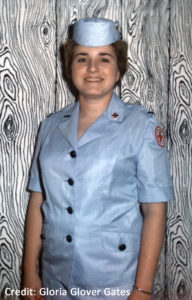
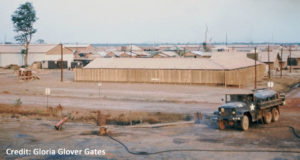
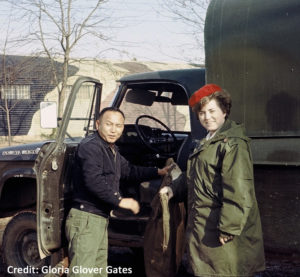
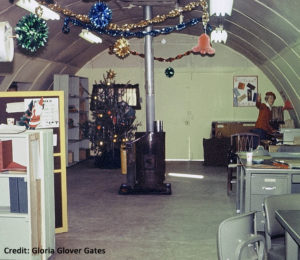
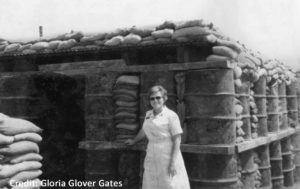
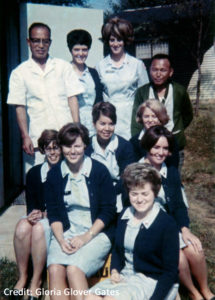

The ships comprised the mobile riverine base, first formed in Jan/Feb 1967. The base consisted of 3 barracks ships and one repair ship that kept all the river boats in service. There were several LSTs which alternated re-supplying the base ships. I was there from the beginning. Unfortunately, no Donut Dollies visited in ’67. However, upon arriving in-country, I was sent to an air base near Vung Tau where I did encounter 2 DDs. Sadly, I did not have a camera with me then, but I do recall their friendliness and positivity. I don’t think we got any donuts though! It took a lot of courage and fortitude to do what they did, especially given the negative opinion of the US military in the 60s. They are all college grads. They certainly had options and they chose to put themselves in harm’s way to aid their country. Bravo Zulu, ladies. We thank you, and, Welcome Home!
Thank you for your Service and Welcome Home!
Thank you for sharing your story Gloria. We went through the same training class in Washington DC, We flew to Korea together, and ended up in the same quonset hut at Camp Humphreys. I have very fond memories of you and that special time in our lives. How interesting and surprising, during this COVID 19 experience sheltering at home, to connect and renew a friendship made over 50 years ago.
Gloria’s story was very interesting, especially since I found myself in the picture of her unit at Camp Humphreys. I read her article because her time frame and name seemed familiar.